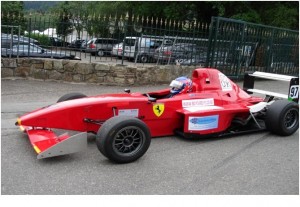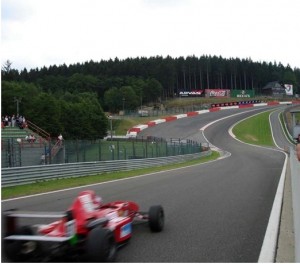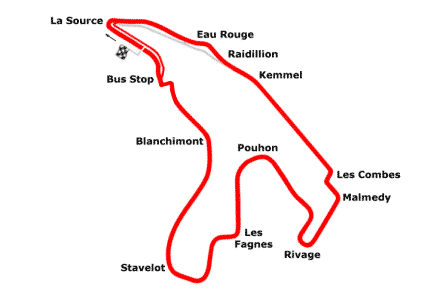Whilst a Van Diemen Formula Ireland is one of the few cars that can’t enter the Sport, Saloon and GT one Hour Challenge race at Spa in October, (due to being an open wheel car) we thought Andy’s description of a flying lap described nicely what Spa Francorchamps is like so we’ve included it here for you to enjoy.
Spa-Francorchamps is often voted the world’s best race track by racing drivers in many championships, from Clubman’s series all the way to Formula One. It is a historic circuit that since its inception in the 1920’s, twists and turns its way through the beautiful hilly environs of the Belgian Ardennes Forest. This undulating countryside brings its own set of challenges in the form of a micro-climate, whereby one minute you can be driving on a sunny dry part of the circuit but 5 corners later you find yourself in the midst in a heavy downpour.
The circuit offers everything the race driver seeks from a track; fast sweeping corners, rapid elevation changes, technically complex corners and long straights with many overtaking opportunities. The circuit is also one of the longest, despite being been cut down from its original 15km to a more manageable 7km or 4.3 miles around 30 years ago.
It was my third visit to Spa-Franchorchamps (my favorite circuit) with the British Monoposto (single seater) series for which this review was written of my first flying lap of qualifying, whereby I set my fastest lap time in non-dry conditions.
I was to be driving the circuit for the first time on a damp track and it was also the first time behind the wheel of this 2002 Van Diemen Formula Ireland, prepared by Nemesis Motorsport. The car is a spaceframe chassis with Penske dampers, Farringon datalogger in the steering wheel with a racing Scholar Ford Zetec engine mated to a Hewland LD200 racing gearbox.

As with the start of all qualifying sessions and races, the drivers wait in the pit lane assembly area for the engine start signal. I am strapped into this strange new car, my heart pounding as I look around the unfamiliar cockpit. Unusual lights and whirring sounds come from the dashboard systems checks as I run through the list. The seatbelts feel too tight over my shoulders and I am struggling to breathe inside my helmet, as curious passers-by stare into my cockpit and poke cameras into the car. I hear the roar of the Medical and Clerk of Course cars as they fly past the pits. Then a whistle blows, the pitlane lights go green and the pitlane marshal drops his flag. Forty race-tuned engines roar into life and judder at an unnaturally slow pace towards the pitlane exit.
For me, the out-lap started as for any non-Grand Prix driver at Spa by exiting the pits after Eau Rouge, snicking through the gears on the long climb up the steep Radillon hill to the Les Combes complex; the car feeling light and positive as it stretches its legs and takes its first lungful of the fresh morning air. During this first installation lap, the driver is very focused on remembering (or learning!) the circuit whilst monitoring the car closely for any sign of systems problems, balance or mechanical issues, all while trying to build up heat in the brakes and tyres and keeping out the way of other traffic. At this point, my heart rate is usually feels like it is racing around 140bpm and my senses are on tenterhooks for the slightest strange noise or twitch from the howling powerplant mounted just 2 inches behind me. I quickly pick up the speed and braking points are left progressively later throughout the installation lap as I build my confidence levels and knowledge of this strange car’s handling characteristics, taking mental notes of any problems and handling issues to report to the team in the pitlane later. Towards the end of the out-lap, the car is truly on-song, and temperatures and pressures look good as I open the taps to the La Source hairpin to start my first flying lap. I am still slightly wary of the tyres, which I know are several seasons old and not performing at their best. I run out wide from the exit, bouncing over the kerbs and nailing the throttle early to gain as much speed as I can for the fast descent down to the world famous Eau Rouge corner.

Approaching Eau Rouge flat out
The corner is very much steeper and tighter on descent and ascent than you can make out in this photo or on TV and consists of a complex series of curves with a blind exit over the brow of the hill, all of which should be taken at full throttle in top gear. No amount of psyching up, TV previewing or circuit walks will prepare you for the monumental leap of faith as you first take this corner ‘flat’ with the rev counter needle bouncing off the limiter, especially the first time in a new car with semi-cold tyres. No written or verbal description can do justice to the feeling of swooping down at over 140mph into the depths of Eau Rouge, your backside only 1 inch above the tarmac, the shoulder straps loosening as the g-forces shove you down further into the car.
Here I reinforce to myself that I must fully exploit the aerodynamics of the car and use the bottoming out effect to give enough downforce and grip to take such a sharp corner at maximum speed (approx. 230kmh / 143mph). I try to minimize my steering input to reduce the loss of speed caused by cornering tyre friction as the car slams violently between negative, positive and lateral g-forces throughout different stages of the corner, throwing back sensory overload through the steering wheel and chassis of the car.
Every time I ride this roller-coaster of a corner, I have to consciously fight my body’s fierce urge to brake and slow down to a non-life threatening speed, mentally chanting, “keep that throttle down, keep that throttle down”. (Incidentally, the problems usually occur here if you are overtaking into the corner and are forced to lift off the throttle, causing a loss of car balance, mechanical grip and aero grip all at the same time causing you to spin out. For this very reason I once ended up rolling backwards up the pit lane exit at 120mph with my left wheels inches from the Armco.)
The optimal way to take this corner is to exit the last stage of the corner on the right third of the track with the highest speed possible for the long drag up the hill. Eau Rouge can make or lose you several seconds, as the speed you carry through the corner makes a huge difference on the following long Radillon straight. Even those in more powerful cars can be left behind on this section for this reason.
At the top of the Radillon straight, I brake hard and late before turning sharply right into the technical Les Combes complex, fighting understeer. In a race, I usually have to compromise the racing line here to ensure that another car doesn’t try to out-brake me into the corner. A quick right-left-right sees me into the short downhill stretch to the bumpy Rivage off-camber hairpin, with nasty understeer pushing the car out wide towards the gravel trap. There is another short downhill to the right-angled left hander at Turn 9, which can almost always be taken faster than you think – if you can suppress the overwhelming desire to jam your foot on the brakes as you drive directly at a tyre wall at over 100mph.
This is followed by another downhill straight to the aggressive corner turn-in at Pouhon, a very fast sweeping downhill left handed double apex corner, which can be taken almost flat out in top gear on the very first flying lap. This is the second of the heart-stopping corners on this incredible circuit. I hold my breath as the car twitches and skips out to the kerb, with the large run-off area beckoning to me. My body is slammed into the right side of the cockpit and there is an incredible strain on my neck muscles as my helmet is shoved sideways by the intense lateral g-forces. Luckily, I judge it right this time, the car runs two wheels out to the edge of the rumble-strips before swooping back onto the blacktop to make the second apex in one long progressive turn. The feeling of getting this right on the first lap boosts the confidence levels and the car suddenly becomes alive in my hands, as I know I can now push the limits out a little further.
I approach the Fagnes chicane, which I turn in late and fast to maintain speed over the kerbs to the following straight. There is another similar looking chicane (Radion – Turn 14) immediately afterwards, and then I am flat on the throttle through Turn 15, the engine screaming at full revs in my ears for over a mile to the Bus Stop. But before reaching that, I have to negotiate the last of the heart-in-your-mouth corners – the feared Blanchimont – at full throttle in top gear.
This is another case of placing your trust in the car as it twitches at the limits of adhesion out to the right hand rumble-strips at well over 130mph, the Armco and tyre walls staring menacingly at you. The damp glistening surface of the track under the trees causes my confidence levels to plummet and it is tempting to lift the throttle here, but I override the urge and keep it nailed. It is common to pass slower cars here and this always adds to the challenge and complexity of the corner, having to make a sudden change of direction or speed on fully loaded tyres at maximum velocity. As I approach Blanchimont, my heart sinks as two slower cars on installation laps are entering the corner side-by-side ahead of me, my closing speed on them approximately 60mph. I have seen several large accidents at this corner and it is not an easy call, but I make a lightning decision to trust their judgment, stay on the throttle and swerve around the outside of both, still travelling at 130+mph as my right-hand tyres squeal protest their treatment at being hurled over the kerbs. There is a heart-stopping ‘tank-slapper’ moment as the car goes all out of shape when the bellypan slides over the kerbs, but then it straightens up as I keep the throttle down and leave the other cars in my wake of flying sparks and burnt hydrocarbons.
I then arrive at almost the last part of the circuit, the Bus Stop chicane, which was re-profiled in 2006 and again the following year. Ahead I see the multi-colored grandstand of spectators opposite the F1 pit garages and the strobe effect of their camera flashes as I aim for a late apex at the right-hand corner and try to optimize the left hand corner exit speed for the dash to La Source. Again I run wide to get onto the throttle earlier, bouncing over the kerbs and charging down the hill to the finish line. I ease off the throttle as I enter Eau Rouge once more and look down at my steering wheel timer to see a ‘2:36.1’ (average speed of 160kph / 100mph), good enough for a provisional pole position on a damp circuit, but the time will eventually place me at P4 for the race the following day.
By Andy Dickens
Spawny Whippet Motorsport
